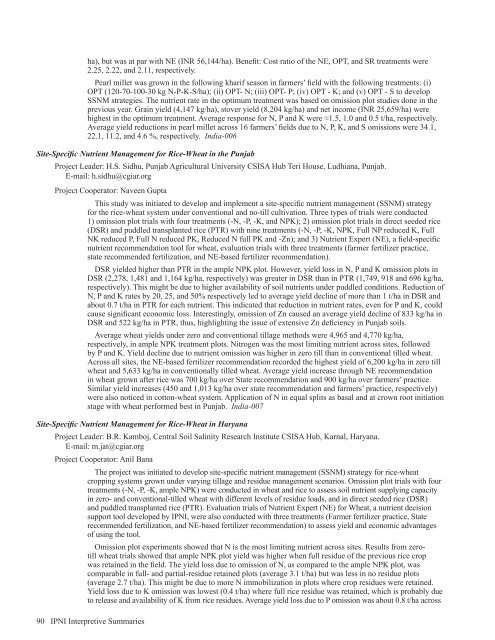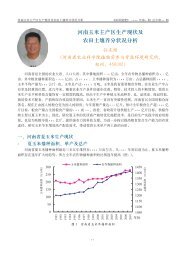Americas and Oceania Group - International Plant Nutrition Institute
Americas and Oceania Group - International Plant Nutrition Institute
Americas and Oceania Group - International Plant Nutrition Institute
Create successful ePaper yourself
Turn your PDF publications into a flip-book with our unique Google optimized e-Paper software.
ha), but was at par with NE (INR 56,144/ha). Benefit: Cost ratio of the NE, OPT, <strong>and</strong> SR treatments were<br />
2.25, 2.22, <strong>and</strong> 2.11, respectively.<br />
Pearl millet was grown in the following kharif season in farmers’ field with the following treatments: (i)<br />
OPT (120-70-100-30 kg N-P-K-S/ha); (ii) OPT- N; (iii) OPT- P; (iv) OPT - K; <strong>and</strong> (v) OPT - S to develop<br />
SSNM strategies. The nutrient rate in the optimum treatment was based on omission plot studies done in the<br />
previous year. Grain yield (4,147 kg/ha), stover yield (8,204 kg/ha) <strong>and</strong> net income (INR 25,659/ha) were<br />
highest in the optimum treatment. Average response for N, P <strong>and</strong> K were ≈1.5, 1.0 <strong>and</strong> 0.5 t/ha, respectively.<br />
Average yield reductions in pearl millet across 16 farmers’ fields due to N, P, K, <strong>and</strong> S omissions were 34.1,<br />
22.1, 11.2, <strong>and</strong> 4.6 %, respectively. India-006<br />
Site-Specific Nutrient Management for Rice-Wheat in the Punjab<br />
Project Leader: H.S. Sidhu, Punjab Agricultural University CSISA Hub Teri House, Ludhiana, Punjab.<br />
E-mail: h.sidhu@cgiar.org<br />
Project Cooperator: Naveen Gupta<br />
This study was initiated to develop <strong>and</strong> implement a site-specific nutrient management (SSNM) strategy<br />
for the rice-wheat system under conventional <strong>and</strong> no-till cultivation. Three types of trials were conducted<br />
1) omission plot trials with four treatments (-N, -P, -K, <strong>and</strong> NPK); 2) omission plot trials in direct seeded rice<br />
(DSR) <strong>and</strong> puddled transplanted rice (PTR) with nine treatments (-N, -P, -K, NPK, Full NP reduced K, Full<br />
NK reduced P, Full N reduced PK, Reduced N full PK <strong>and</strong> -Zn); <strong>and</strong> 3) Nutrient Expert (NE), a field-specific<br />
nutrient recommendation tool for wheat, evaluation trials with three treatments (farmer fertilizer practice,<br />
state recommended fertilization, <strong>and</strong> NE-based fertilizer recommendation).<br />
DSR yielded higher than PTR in the ample NPK plot. However, yield loss in N, P <strong>and</strong> K omission plots in<br />
DSR (2,278, 1,481 <strong>and</strong> 1,164 kg/ha, respectively) was greater in DSR than in PTR (1,749, 918 <strong>and</strong> 696 kg/ha,<br />
respectively). This might be due to higher availability of soil nutrients under puddled conditions. Reduction of<br />
N, P <strong>and</strong> K rates by 20, 25, <strong>and</strong> 50% respectively led to average yield decline of more than 1 t/ha in DSR <strong>and</strong><br />
about 0.7 t/ha in PTR for each nutrient. This indicated that reduction in nutrient rates, even for P <strong>and</strong> K, could<br />
cause significant economic loss. Interestingly, omission of Zn caused an average yield decline of 833 kg/ha in<br />
DSR <strong>and</strong> 522 kg/ha in PTR, thus, highlighting the issue of extensive Zn deficiency in Punjab soils.<br />
Average wheat yields under zero <strong>and</strong> conventional tillage methods were 4,965 <strong>and</strong> 4,770 kg/ha,<br />
respectively, in ample NPK treatment plots. Nitrogen was the most limiting nutrient across sites, followed<br />
by P <strong>and</strong> K. Yield decline due to nutrient omission was higher in zero till than in conventional tilled wheat.<br />
Across all sites, the NE-based fertilizer recommendation recorded the highest yield of 6,200 kg/ha in zero till<br />
wheat <strong>and</strong> 5,633 kg/ha in conventionally tilled wheat. Average yield increase through NE recommendation<br />
in wheat grown after rice was 700 kg/ha over State recommendation <strong>and</strong> 900 kg/ha over farmers’ practice.<br />
Similar yield increases (450 <strong>and</strong> 1,013 kg/ha over state recommendation <strong>and</strong> farmers’ practice, respectively)<br />
were also noticed in cotton-wheat system. Application of N in equal splits as basal <strong>and</strong> at crown root initiation<br />
stage with wheat performed best in Punjab. India-007<br />
Site-Specific Nutrient Management for Rice-Wheat in Haryana<br />
Project Leader: B.R. Kamboj, Central Soil Salinity Research <strong>Institute</strong> CSISA Hub, Karnal, Haryana.<br />
E-mail: m.jat@cgiar.org<br />
Project Cooperator: Anil Bana<br />
The project was initiated to develop site-specific nutrient management (SSNM) strategy for rice-wheat<br />
cropping systems grown under varying tillage <strong>and</strong> residue management scenarios. Omission plot trials with four<br />
treatments (-N, -P, -K, ample NPK) were conducted in wheat <strong>and</strong> rice to assess soil nutrient supplying capacity<br />
in zero- <strong>and</strong> conventional-tilled wheat with different levels of residue loads, <strong>and</strong> in direct seeded rice (DSR)<br />
<strong>and</strong> puddled transplanted rice (PTR). Evaluation trials of Nutrient Expert (NE) for Wheat, a nutrient decision<br />
support tool developed by IPNI, were also conducted with three treatments (Farmer fertilizer practice, State<br />
recommended fertilization, <strong>and</strong> NE-based fertilizer recommendation) to assess yield <strong>and</strong> economic advantages<br />
of using the tool.<br />
Omission plot experiments showed that N is the most limiting nutrient across sites. Results from zerotill<br />
wheat trials showed that ample NPK plot yield was higher when full residue of the previous rice crop<br />
was retained in the field. The yield loss due to omission of N, as compared to the ample NPK plot, was<br />
comparable in full- <strong>and</strong> partial-residue retained plots (average 3.1 t/ha) but was less in no residue plots<br />
(average 2.7 t/ha). This might be due to more N immobilization in plots where crop residues were retained.<br />
Yield loss due to K omission was lowest (0.4 t/ha) where full rice residue was retained, which is probably due<br />
to release <strong>and</strong> availability of K from rice residues. Average yield loss due to P omission was about 0.8 t/ha across<br />
90 IPNI Interpretive Summaries

















